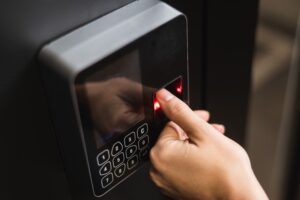In today’s digital age, securing access to personal data and sensitive information has become increasingly critical.
Biometric verification has emerged as a reliable and convenient method to identify and authenticate individuals by leveraging unique biological traits. This technology is now embedded in various aspects of daily life, from unlocking smartphones to airport security checks.
Let’s explore what biometric verification is, how it works, the different types of biometric systems, and where this technology is commonly used.
What is Biometric Verification?
Biometric verification is a method of identifying and validating individuals based on their unique biological characteristics. These characteristics include fingerprints, facial patterns, voiceprints, iris patterns, and more. Biometric verification answers the question, “Who are you?” in a digital environment, allowing individuals to gain access to systems, services, or devices.
Unlike traditional methods of authentication, such as passwords or PINs, biometrics are inherently tied to the individual and are difficult to forge or replicate. This makes biometric verification one of the most secure methods of identity validation.
How Does a Biometric Verification System Work?
The process of biometric verification involves several key steps.
First, a biometric sample, such as a fingerprint or facial scan, is captured from the individual. This sample is then converted into a digital template, which is stored securely in a database. When the individual needs to be authenticated, a new biometric sample is taken and compared to the stored template. If the two match, the person’s identity is verified.
Biometric systems can work both online and offline, depending on the application. For instance, online systems might use cloud technology to store and process biometric data, allowing for remote verification. Offline systems, on the other hand, typically use local storage and processing, which might be more suitable for high-security environments.
What Are the Types of Biometric Verification?
Face Recognition
Face recognition technology uses the unique features of an individual’s face, such as the shape of the chin or the distance between the eyes, to identify and authenticate them. This method is widely used in smartphones, where users can unlock their devices by simply looking at the camera. The system works by capturing a digital image of the face and comparing it to a stored template. While highly effective, face recognition can be less reliable for children and elderly individuals whose facial features may change over time.
Iris and Retina Pattern Recognition
Iris and retina pattern recognition are among the most secure forms of biometric verification. The iris and retina have complex, unique patterns that remain stable throughout a person’s life. These patterns are captured using specialized scanners and compared to stored templates for authentication. This technology is commonly used in high-security environments, such as military installations and banking systems.
Fingerprint Scanning
Fingerprint scanning is one of the oldest and most widely used forms of biometric verification. Each individual’s fingerprint has unique ridges and patterns that can be used to identify them. Fingerprint scanners are now common in smartphones, allowing users to unlock their devices or authorize payments with a simple touch. This method is also used in government-issued IDs, such as passports, where fingerprints are stored in a database for verification.
Voice Recognition
Voice recognition technology analyzes the unique characteristics of a person’s voice, such as pitch, tone, and frequency, to verify their identity. This method is often used in customer service applications, where individuals can be authenticated over the phone. Voice recognition can be implemented with either text-dependent or text-independent systems, where the former requires the user to say a specific phrase, and the latter allows for free speech. However, voice recognition is more susceptible to fraud, such as deepfake attacks, compared to other biometric methods.
Signature Recognition
Signature recognition analyzes the way an individual signs their name, considering factors such as speed, pressure, and the shape of the signature. Although less common than other forms of biometrics, signature recognition is still used in some financial institutions and legal applications where handwritten signatures are required. However, this method is more prone to forgery and less reliable than other biometric verification techniques.
Where is Biometric Verification Used?
Mobile Access and Authentication
Biometric verification is increasingly used in mobile devices for access control and authentication. Smartphones now commonly feature fingerprint scanners and facial recognition technology, allowing users to unlock their devices and authorize transactions securely and conveniently. This seamless integration of biometrics into mobile technology has made it easier for users to access their data while maintaining high levels of security.
Airport Security
Airports worldwide are adopting biometric verification to enhance security and streamline passenger processing. Biometric systems, such as facial recognition and iris scanning, are used at security checkpoints, boarding gates, and customs to verify travelers’ identities quickly and accurately. This technology not only improves security but also reduces wait times for passengers, making the travel experience more efficient.
Online Banking
In the financial sector, biometric verification provides a secure way for customers to access their online banking accounts. Banks are increasingly using fingerprint and facial recognition as authentication methods, replacing traditional passwords and PINs. This approach not only enhances security but also simplifies the user experience, allowing customers to perform transactions quickly and safely from their mobile devices.
Remote Identity Verification
With the rise of digital services, remote identity verification has become essential for businesses to comply with Know Your Customer (KYC) regulations and prevent fraud. Biometric verification, combined with document verification, enables businesses to verify the identity of their customers remotely. For example, a user may be asked to submit a photo ID and a selfie during the onboarding process. The system then uses facial recognition to match the selfie with the photo on the ID, ensuring that the person is who they claim to be.
Conclusion
Biometric verification has become a cornerstone of modern security systems, offering a reliable and convenient way to authenticate individuals based on their unique biological traits. From mobile devices to airport security and online banking, biometrics are being integrated into various aspects of daily life, providing enhanced security and a seamless user experience. As technology continues to evolve, the use of biometrics is expected to expand, making it an even more integral part of our digital lives.






